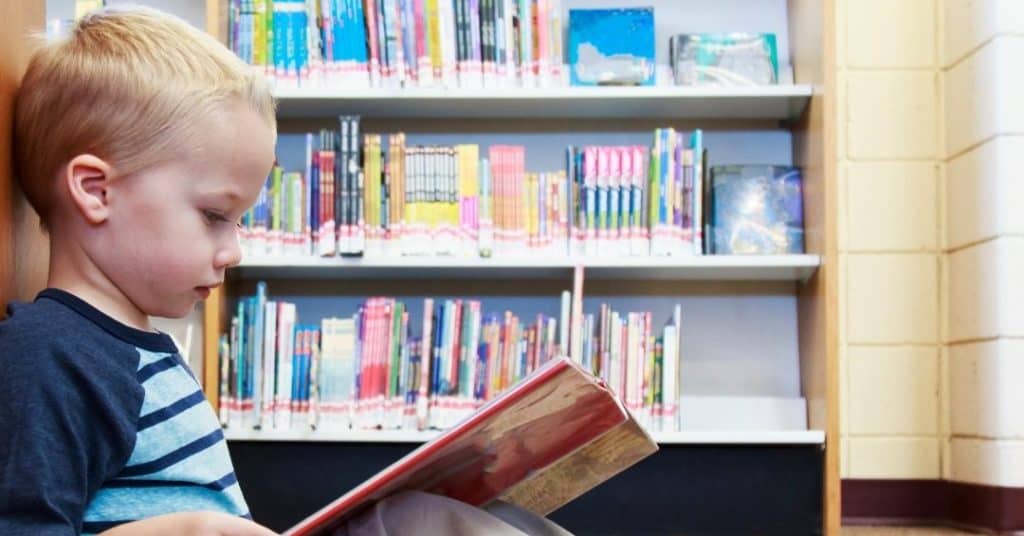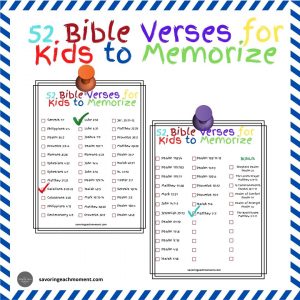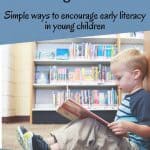Reading skills begin to develop in young children long before they learn to recognize letters and decode simple words. Preschool reading activities or early literacy concepts are a great way to easily to build into your play-time with your child.
There are so many different ways to add learning fun into early childhood education with hands-on activities before your young readers are even realizing they are learning to read!
The more you surround your child with books, learning, and words, the easier it will be for them to learn to read and decode words on their own. You are probably here because you are looking for some preschool reading activities. If so, you are in the right place!
Reading is an essential skill in life and having a solid reading foundation will help your child all throughout their learning. As you think about learning, reading is foundational to math, science, social studies, and of course the written word and narrative skills will be used throughout life.
As a parent and teacher, these are some of the preschool reading activities and early literacy activities for young children that I have found have worked with my own children and also my students.
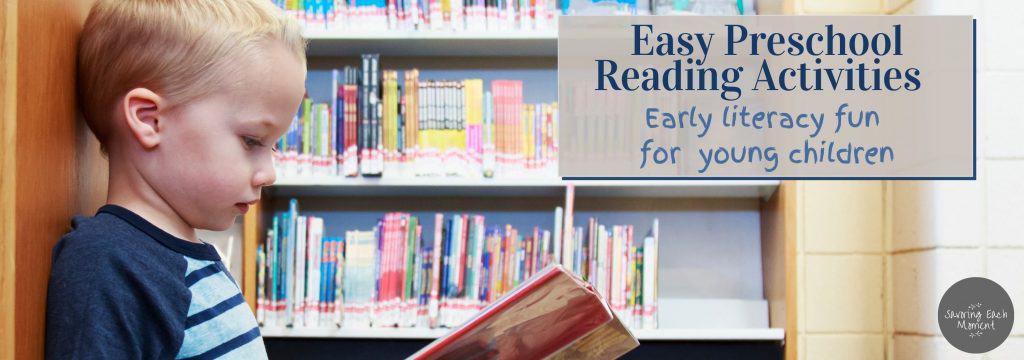
This post may contain affiliate links. That simply means that I may receive a small commission when you purchase something through the link at no additional cost to you.
Why Early Literacy Activities Are Important for Preschoolers
At a very young age, your child’s mind is primed for learning. They are learning new words, new sounds, putting words together to make sentences, and figuring out how to communicate. They are observing, listening, and watching to see how other people interact in their world and then copying or repeating those actions to test if they work for them.
This is the perfect time to encourage your preschool child with pre-reading activities that will help them build a solid foundation for literacy and reading as they grow. Learning nursery rhymes, spending time with your favorite book during reading time, helping your child to recognize the letters and sounds in their name are all part of learning to read. You don’t have to be a preschool teacher to help your child with early reading skills.
The very best way to engage your child and teach them at this age, is to encourage them to learn through play. A child’s life is full of play but through that play, they are making connections, testing hypothesis, and learning. Letter recognition, picture books, working on fine motor skills are all an important part of the reading process.
After a child can recognize the letters of the alphabet, they can begin to increase their phonological awareness and work on sight words, print awareness and letter names.
When you start thinking about early literacy activities for preschoolers, you need to think about the words you use to encourage learning when you are playing with your child. Talk through the process of learning with your child. For example: “See this picture of the cat? Cat starts with the letter C. Sounds like K-k-k. What sound does dog start with?” Help them break down the individual sounds of different letters and words.
If you’d like to learn more about play-based learning, you can find out more information here: Learning Through Play – Capturing Teachable Moments with Young Children
Simple Preschool Reading Activities You Can Do Today
You don’t have to purchase a lot of expensive toys or buy top-of-the-line books to provide early literacy activities for your preschool child. Take advantage of the books and resources you do have and expand on those as your child grows. The following list of preschool reading activities will help your child build a strong base for reading.
- Play games with words – Encourage your child to explore words that are fun to say. Rhyming words that sound alike such as cat, hat, rat, fat, etc. Tell stories with rhyming words and lead your child to find words that will fill in the blank of the story. Playing word games can give your child a head start on communication skills, language development, and provide valuable skills as you communicate back and forth. All of these simple activities can build a child’s skills to help children become good readers.
- Read aloud – You absolutely can NOT read aloud too much to a child when they are young. If they are interested and listening, keep reading! Find books about topics that they are interested in and encourage their learning. Reading aloud to your child provides them with vocabulary, helps them learn how to infer meaning to words and sentences, and will help them with punctuation as you read with voice inflection.
- Encourage a love of books – Provide access to books for your child. You will also need to teach them which books are theirs and how to handle them carefully. The more they see you reading books, the more they will want to mimic or copy that behavior. If they see you enjoying reading to them, they will want to learn to read to you. Or, they might even “read” their own story by looking at the pictures. Use fun facial expressions when you are reading and make sure your body language shows your love of reading. Find a great alphabet book to encourage your child to connect the sounds of the letters with the pictures on the page to develop their phonemic awareness.
- Memorize together – A young child’s mind is like a sponge when it comes to memorizing. They are learning hundreds of new things every single day so adding in intentional memory work, will not be difficult. Memorize finger plays, songs, Bible verses (yes, a 3-year is old enough to memorize Scripture!), tongue twisters, or silly jokes.
Get this awesome printable list of Bible verses for your kids to start memorizing today! 📌
- Read books that are predictable – Books with repetitive story lines or stories that build on the previous page are great early literacy activities for preschoolers. Books such as “If you Give a Mouse a Cookie” or “Inside a Barn in the Country” allow your child to predict and anticipate what is coming next.
- Play the alphabet game – Once your child can recognize different letters, encourage them to find those letters on signs, on food labels or packages, book titles on your shelf, or anywhere else they can find letters.
Preschool Pre-Reading Activities
There are tons of preschool pre-reading activities you can do with your child long before they are starting to think about reading. The following list of pre-reading activities for your preschooler will help you to recognize the opportunities you have to encourage learning.
- Matching – Whether you are playing a matching game like “Memory” or just looking for things that are alike, you will help your child develop the skills to recognize things that are the same and different. This will help your child to begin to identify the difference between the letters b, p, and d. This skill also helps them start to recognize the difference between words and sounds as they begin to read.
- Spelling – Help your child learn the ABC song. Practice the sounds of the letters and try sounding out words or finding words that have certain letter sounds in them. Give a few examples of words that start with t-t-t turtle, t-t-t-teddy bear, and then help your child discover additional words that begin with the letter t. Encourage your child to find something else and then work on the corresponding letter sound and what other things being with the same sound.
- Letters – Surrounding your child with alphabet letters and numbers will help them to identify the different letters and numbers and also help them find letters that have certain sounds. Alphabet magnets on the fridge, vinyl sticker letters for the window, and letter-shaped sponges in the bathtub during bath time are simple ways to surround your child with shapes that they will learn to recognize and associate meaning to them. You can work with your child to create colorful letters with different colored play do, play or pipe cleaners. Use your child’s favorite toys to springboard conversations about letters and sounds.
Play is the highest form of research ~ Albert Einstein
- Rhyming – Children love to discover things and when you introduce them to the concept of rhyming words and sounds, they will enjoy finding more words that rhyme. Start by reading some books that have lots of rhyming words and let your child predict what the words will be. Once they’ve learned what that means, you can start to play games like I Spy, or can you think of something that sounds like “hat”?
- Opposites – It’s easy to add opposites into your conversation with your kids just like adding rhyming words. Read some books about opposites and let your child discover the opposite word by looking at the pictures.
- Tell a story – Tell a story with your child using felts, sequence cards, pictures, toys, or by drawing pictures on construction paper or in a notebook. Help your child learn to put things in order using words like first, then, after that, finally, and the end. As your child learns to put events together in sequential order, this will help them as they formulate their own stories and later on learn to write their stories.
- Write their name – Children love to pretend to write as they see the people around them writing. Help them write their names and learn to identify the letters in their name. Be sure to help them learn to write the letters properly and with uppercase letters at the beginning of their name and lower-case letters for the rest.
- Drawing – Drawing may not seem like a pre-reading skill at first glance, but if your child learns to recognize and draw different shapes, lines, and gain skill in eye-hand coordination, they will also recognize the differences between letter shapes such as b and p or see that the letter o is the same as a circle. These literacy connections strengthen their interest and knowledge and prepare them for reading. Get a drawing book like these amazing Draw Write Now books and help your child learn to draw following a sequence. (My kids LOVED these books!)
- Letter puzzles – Puzzles and hands-on toys that encourage alphabet recognition and putting pieces together also help a child learn to identify shapes, direction, and working through a thought process to solve or put the puzzle together. Encourage your child to look for clues to help them put the pieces together so they learn to work through things that are hard and keep at it. (Our favorite puzzles are Lauri crepe rubber puzzles!
- Sequencing and Patterns – Provide your child with things that they can put into patterns in a fun way. This can be as simple as different types of large pasta noodles, big, colorful buttons, or different colors or sizes of toys. Help your child identify the pattern and then continue it with the correct order. Line up the noodles and create a pattern such as big, big, little, little, or round, straight, round, straight, etc. Younger children can do this with buttons or beads on a string or pipe cleaner chenille stem. Young students can easily begin to identify patterns in everyday items even at an early age.
Is My Child Too Young to Start Reading?
This question is a valid one. And the answer will vary for every single child. I have known children who started reading (actually reading) when they were 3 or 4, but most children learn to read when they are 5, 6, or 7. The children I’ve known who started reading very young developed this interest on their own. Using pre-reading activities and encouraging early literacy activities for your preschool child will help them have a solid base when they are ready to start reading.
Preschool students and young children develop at different stages and ages, and trying to push a very young child to learn something they aren’t developmentally ready for, will only cause frustration. This is why it so important to encourage the fun of learning through natural play and curiosity. This will ensure that your child is ready for the next or more complex building blocks of learning. Using preschool reading activities to encourage exploration and their main pre-reading skills will help a child develop naturally at their own pace.
Your child has a life of learning ahead of them. Don’t rush them into something just because your friend’s child can already do it. Allow your child the time and space to be a child. Let them explore, play, and learn about the things around them. Encourage them to build those learning blocks, but don’t try to build a skyscraper when they are only ready to build with blocks. Use lots of preschool reading activities and immerse your child with words and wonder and they will be set for success.
Make Learning Fun with Literacy Activities for Kids
Learning should be fun – especially for young children. Let them learn through playing and encourage that for them. These precious, short years will go by so quickly and your child will be off to school. Treasure these moments you have with your child and have fun together. Pick a few of these ideas above and try them out with your child. As they grow and learn, add some more things in the next time. As they grow from a simple sentence to speaking in paragraphs and whole ideas, you will have so much fun watching the wonder as they learn. The best ways to encourage your child to learn is to tailor the playing and learning to their interests and get right in there and play with them.
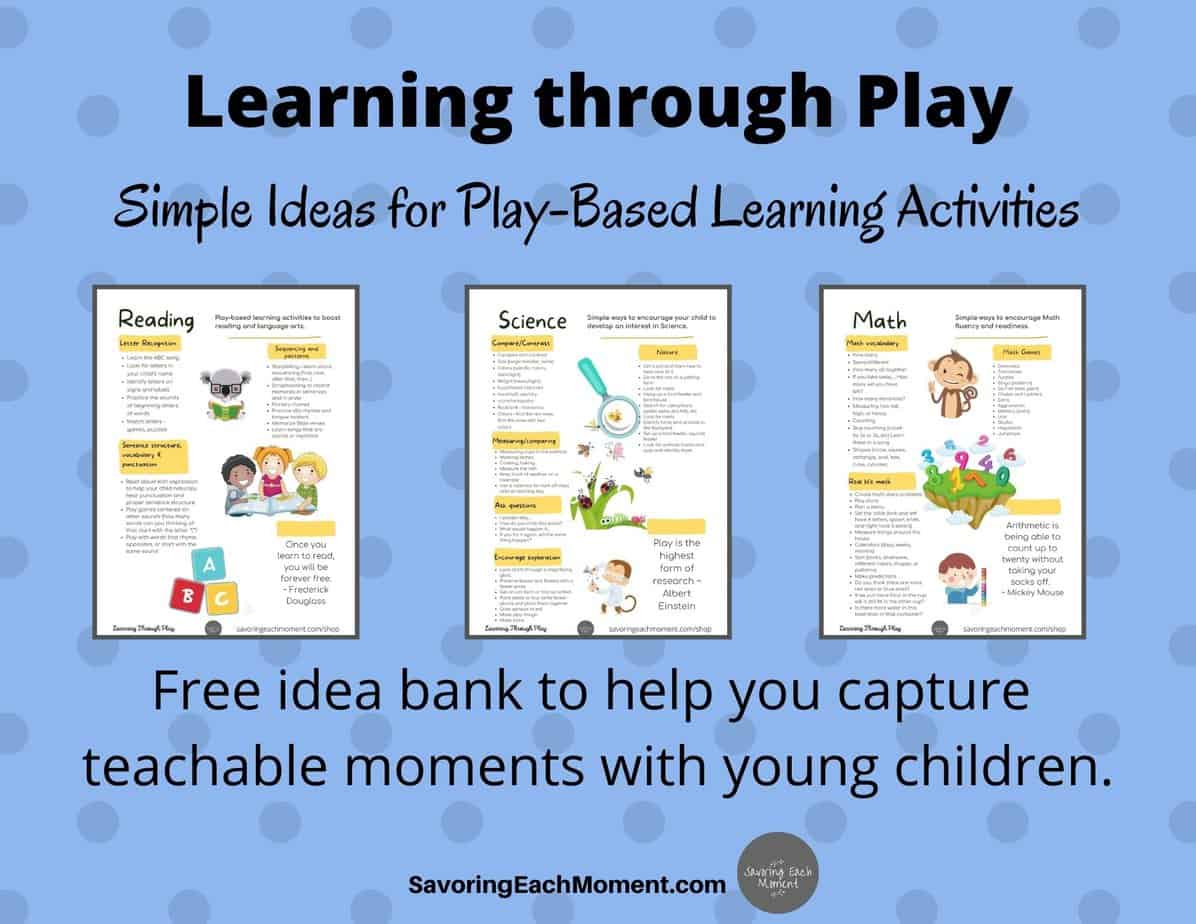
You May Also Like These Posts
- Exploring Nature with Children
- Simple Math Activities for Preschoolers
- Preschool Reading Activities
- Questions to Ask When Choosing a Preschool
- Awesome Lunch Box Notes for Kids
- Books About Winter
- Simple Fall Science Activities for Preschoolers
- Memorable Valentine’s Day Traditions to Begin with Your Kids
❣ Sign up to get our weekly email filled with encouragement, ideas, and support for moms raising kids who love Jesus! ❣

